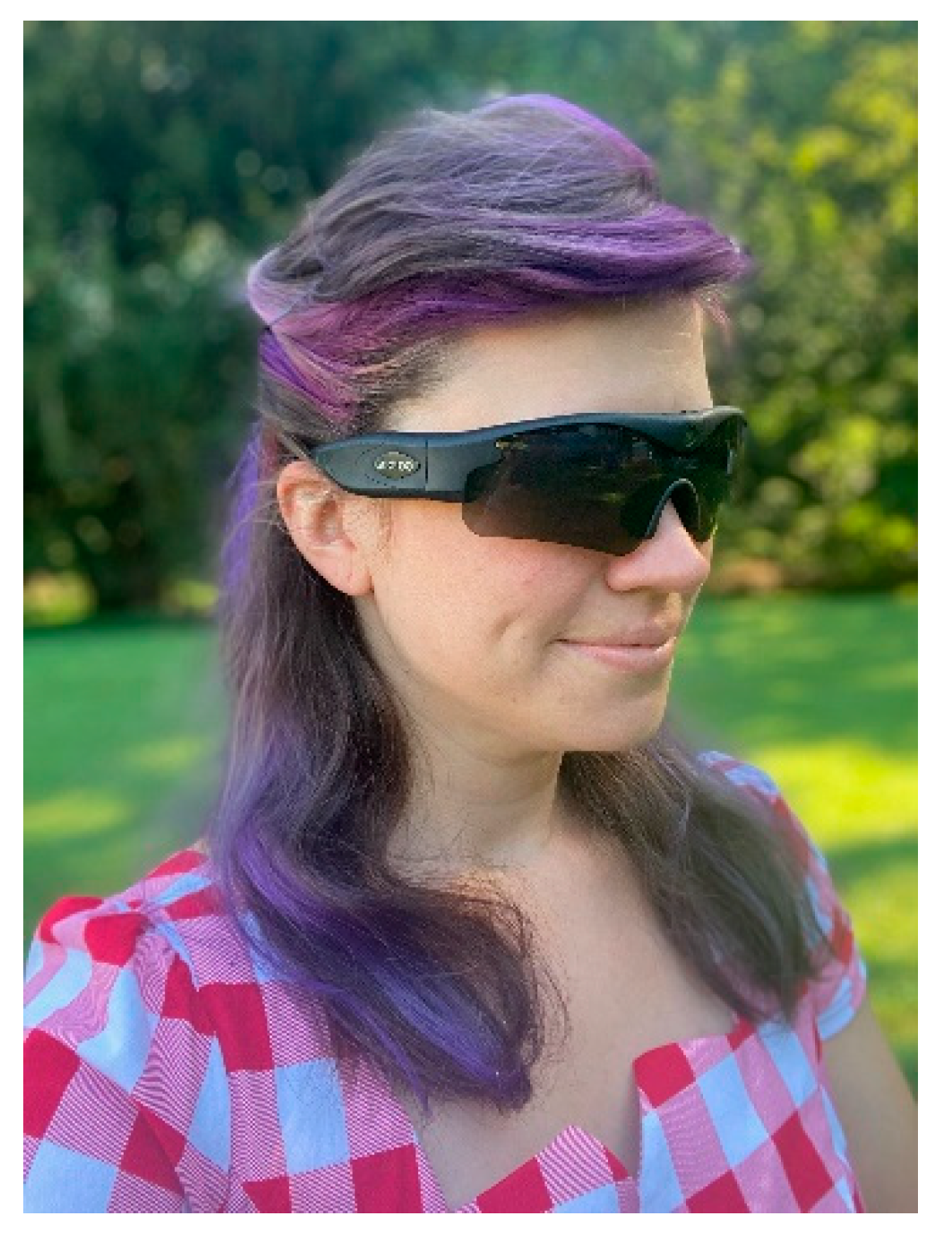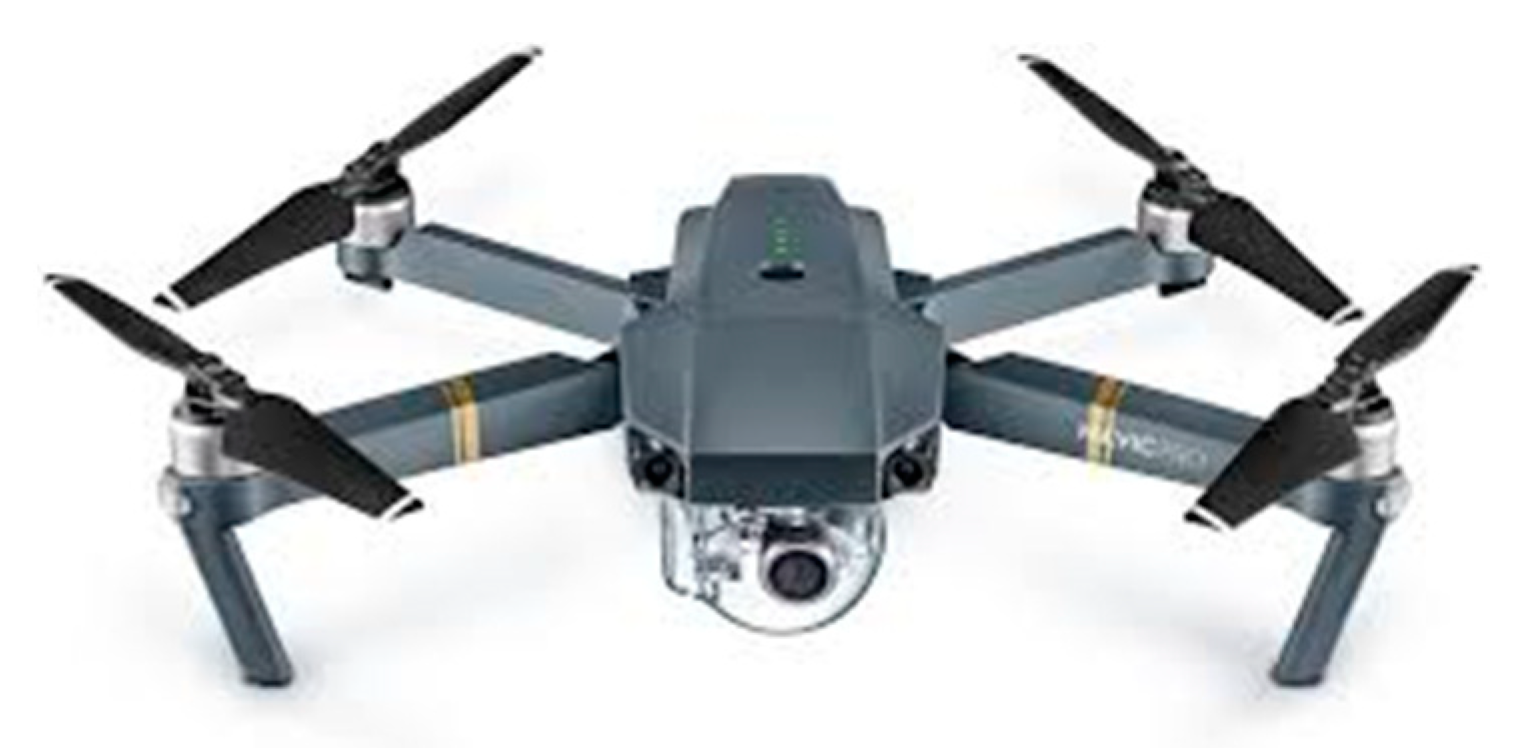Assessing Park Quality with a Wearable Video Device and an Unmanned Aerial System
Abstract
1. Introduction
2. Materials and Methods
2.1. Data Collection Devices
2.1.1. Wearable Video Device–Gogloo E7 SMART
2.1.2. Unmanned Aerial System (UAS)
2.2. Parks
2.3. The Physical Activity Resource Assessment (PARA)
2.4. Procedures
2.5. Statistical Analysis
3. Results
3.1. Feature Quality: In-Person versus WVD
3.2. Feature Quality: In-Person versus UAS
3.3. Amenity Quality: In-Person versus WVD
3.4. Amenity Quality: In-Person versus UAS
3.5. Incivility Severity: In-Person versus WVD
3.6. Incivility Severity: In-Person versus UAS
4. Discussion
5. Conclusions
Author Contributions
Funding
Institutional Review Board Statement
Informed Consent Statement
Data Availability Statement
Conflicts of Interest
References
- Carlson, S.; Fulton, J.; Pratt, M.; Yang, Z.; Adams, E. Inadequate physical activity and health care expenditures in the United States. Prog. Cardiovasc. Dis. 2015, 57, 315–323. [Google Scholar] [CrossRef] [PubMed]
- National Center for Health Statistics (US). Health, United States, 2015: With Special Feature on Racial and Ethnic Health Disparities; National Center for Health Statistics: Hyattsville, MD, USA, 2016.
- National Physical Activity Plan Alliance. 2016 United States Report Card on Physical Activity for Children and Youth; National Physical Activity Plan Alliance: Columbia, SC, USA, 2016. [Google Scholar]
- Wang, Y.; Beydoun, M.A. The Obesity Epidemic in the United States-Gender, Age, Socioeconomic, Racial/Ethnic, and Geographic Characteristics: A Systematic Review and Meta-Regression Analysis. Epidemiol. Rev. 2007, 29, 6–28. [Google Scholar] [CrossRef] [PubMed]
- Tucker, J.M.; Welk, G.J.; Beyler, N.K. Physical activity in U.S.: Adults compliance with the Physical Activity Guidelines for Americans. Am. J. Prev. Med. 2011, 40, 454–461. [Google Scholar] [CrossRef] [PubMed]
- Troiano, R.P.; Berrigan, D.; Dodd, K.W.; Masse, L.C.; Tilert, T.; McDowell, M. Physical activity in the United States measured by accelerometer. Med. Sci. Sports Exerc. 2008, 40, 181–188. [Google Scholar] [CrossRef]
- Jefferis, B.J.; Sartini, C.; Lee, I.M.; Choi, M.; Amuzu, A.; Gutierrez, C.; Casas, J.P.; Ash, S.; Lennnon, L.T.; Wannamethee, S.G.; et al. Adherence to physical activity guidelines in older adults, using objectively measured physical activity in a population-based study. BMC Public Health 2014, 14, 382. [Google Scholar] [CrossRef] [PubMed]
- Ward, B.; Clarke, T.; Nugent, C.; Schiller, J. Early Release of Selected Estimates Based on Data from the 2015 National Health Interview Survey. U.S. Department of Health and Human Services, Centers for Disease Control and Prevention, National Center for Health Statistics Released 05/16. Available online: https://www.cdc.gov/nchs/data/nhis/earlyrelease/earlyrelease201605.pdf (accessed on 13 September 2022).
- Omura, J.D.; Carlson, S.A.; Brown, D.R.; Hopkins, D.P.; Kraus, W.E.; Staffileno, B.A.; Thomas, R.J.; Lobelo, F.; Fulton, J.E.; American Heart Association Physical Activity Committee of the Council on Lifestyle and Cardiometabolic Health; et al. Built Environment Approaches to Increase Physical Activity: A Science Advisory From the American Heart Association. Circulation 2020, 142, e160–e166. [Google Scholar] [CrossRef]
- Heath, G.W.; Parra, D.C.; Sarmiento, O.L.; Andersen, L.B.; Owen, N.; Goenka, S.; Montes, F.; Brownson, R.C.; Lancet Physical Activity Series Working Group. Evidence-based intervention in physical activity: Lessons from around the world. Lancet 2012, 380, 272–281. [Google Scholar] [CrossRef]
- Healthy People. 2020 Topics and Objectives, Physical Activity. Office of Disease Prevention and Health Promotion, 2020. Available online: https://wayback.archive-it.org/5774/20220414132940/https:/www.healthypeople.gov/2020/topics-objectives/topic/physical-activity/objectives (accessed on 15 September 2022).
- Task Force on Community Preventive Services. Recommendations to increase physical activity in communities. Am. J. Prev. Med. 2002, 22, 67–72. [Google Scholar] [CrossRef]
- Sallis, J.F.; Spoon, C.; Cavill, N.; Engelberg, J.K.; Gebel, K.; Parker, M.; Thornton, C.M.; Ding, D. Co-benefits of designing communities for active living: An exploration of literature. Int. J. Behav. Nutr. Phys. Act. 2015, 12, 30. [Google Scholar] [CrossRef]
- Bancroft, C.; Joshi, S.; Rundle, A.; Hutson, M.; Chong, C.; Weiss, C.C.; Genkinger, J.; Lovasi, G. Association of proximity and density of parks and objectively measured physical activity in the United States: A systematic review. Soc. Sci. Med. 2015, 138, 22–30. [Google Scholar] [CrossRef]
- Cohen, D.A.; Han, B.; Marsh, T.; Williamson, S.; Evenson, K.R.; Nagel, C.; McKenzie, T.L.; Harnik, P. The prevalence and use of walking loops in neighborhood parks: A national study. Environ. Health Perspect. 2017, 125, 170–174. [Google Scholar] [CrossRef] [PubMed]
- Fair, M.L.; Kaczynski, A.T.; Hughey, S.M.; Besenyi, G.M.; Powers, A.R. An Initiative to Facilitate Park Usage, Discovery, and Physical Activity among Children and Adolescents in Greenville County, South Carolina, 2014. Prev. Chronic Dis. 2017, 14, 14. [Google Scholar] [CrossRef] [PubMed]
- Van, C.J.; Deforche, B.; Van, C.J.; Cerin, E.; Timperio, A.; Salmon, J.; Veitch, J.; Deforche, B. Is the association between park proximity and recreational physical activity among mid-older aged adults moderated by park quality and neighborhood conditions? Int. J. Environ. Res. Public Health 2017, 14, 192. [Google Scholar]
- Center for City Park Excellence. The Trust for Public Land. 2014 City Park Facts. Available online: https://www.tpl.org/wp-content/uploads/2014/04/2014_CityParkFacts.pdf (accessed on 15 September 2022).
- Rung, A.L.; Mowen, A.J.; Broyles, S.T.; Gustat, J. The role of park conditions and features on park visitation and physical activity. J. Phys. Act. Health 2011, 8, S178–S187. [Google Scholar] [CrossRef] [PubMed]
- Knapp, M.; Gustat, J.; Darensbourg, R.; Myers, L.; Johnson, C. The relationships between park quality, park usage, and levels of physical activity in low-income, African American Neighborhoods. Int. J. Environ. Res. Public Health JERPH 2019, 16, 85. [Google Scholar] [CrossRef] [PubMed]
- Kaczynski, A.T.; Besenyi, G.M.; Stanis, S.A.W.; Koohsari, M.J.; Oestman, K.B.; Bergstrom, R.; Potwarka, L.R.; Reis, R.S. Are park proximity and park features related to park use and park-based physical activity among adults? Variations by multiple socio-demographic characteristics. Int. J. Behav. Nutr. Phys. Act. 2014, 11, 146. [Google Scholar] [CrossRef]
- Cohen, D.A.; Han, B.; Isacoff, J.; Shulaker, B.; Williamson, S. Renovations of neighbourhood parks: Long-term outcomes on physical activity. J. Epidemiol. Community Health 2019, 73, 214–218. [Google Scholar] [CrossRef]
- Duncan, M.J.; Bell, T.; Austin, G. The effect of local neighbourhood park redevelopments on park visitations and user physical activity levels: A pe–post test evaluation. J. Public Health 2021. [Google Scholar] [CrossRef]
- Bedimo-Rung, A.L.; Mowen, A.J.; Cohen, D.A. The significance of parks to physical activity and public health: A conceptual model. Am. J. Prev. Med. 2005, 28, 159–168. [Google Scholar] [CrossRef]
- Evenson, K.R.; Jones, S.A.; Holliday, K.M.; Cohen, D.A.; McKenzie, T.L. Park characteristics, use, and physical activity: A review of studies using SOPARC (System for Observing Play and Recreation in Communities). Prev. Med. 2016, 86, 153–156. [Google Scholar] [CrossRef]
- Joseph, R.P.; Maddock, J.E. Observational Park-based physical activity studies: A systematic review of the literature. Prev. Med. 2016, 89, 257–277. [Google Scholar] [CrossRef] [PubMed]
- Lee, R.E.; Booth, K.M.; Reese-Smith, J.Y.; Regan, G.; Howard, H.H. The Physical Activity Resource Assessment (PARA) instrument: Evaluating features, amenities and incivilities of physical activity resources in urban neighborhoods. Int. J. Behav. Nutr. Phys. Act. 2005, 2, 13. [Google Scholar] [CrossRef] [PubMed]
- Suminski, R.R.; Dominick, G.; Saponaro, P.; Orsega-Smith, E.M.; Plautz, E.; Sapanaro, M. High-Tech Video Capture and Analysis for Providing Counts of Park Users. J. Meas. Phys. Behav. 2020, 3, 147–156. [Google Scholar] [CrossRef]
- Marquet, O.; Hipp, J.A.; Alberico, C.; Huang, J.H.; Fry, D.; Mazak, E.; Lovasi, G.S.; Floyd, M.F. Use of SOPARC to assess physical activity in parks: Do race/ethnicity, contextual conditions, and settings of the target area, affect reliability? BMC Public Health 2019, 19, 1730. [Google Scholar] [CrossRef]
- Grubesic, T.H.; Wallace, D.; Chamberlain, A.W.; Nelson, J.R. Using unmanned aerial systems (UAS) for remotely sensing physical disorder in neighborhoods. Landsc. Urban Plan. 2018, 169, 148–159. [Google Scholar] [CrossRef]
- Suminski, R.R.; Dominick, G.M.; Saponaro, M. Comparing counts of park users with a wearable video device and an unmanned aerial system. Behavior. J. Meas. Phys. Behav. 2021, 4, 143–150. [Google Scholar] [CrossRef]
- Carlson, J.; Liu, B.; Sallis, J.; Kerr, J.; Hipp, J.; Staggs, V.; Vasconcelos, N. Automated Ecological Assessment of Physical Activity: Advancing Direct Observation. Int. J. Environ. Res. Public Health 2017, 14, 1487. [Google Scholar] [CrossRef]
- Park, K.; Ewing, R. The usability of unmanned aerial vehicles (UASs) for measuring park-based physical activity. Land Urban Plan. 2017, 167, 157–164. [Google Scholar] [CrossRef]
- Park, K.; Ewing, R. The usability of unmanned aerial vehicles (UASs) for pedestrian observation. J. Plan Edu. Res. 2018, 42, 206–217. [Google Scholar] [CrossRef]
- Redmon, J.; Ali, F. Yolov3: An incremental improvement. arXiv 2018, arXiv:1804.02767. [Google Scholar]
- Mertes, J.D.; Hall, J.R. Park, Recreation, Open Space and Greenway Guidelines; National Recreation and Park Assc: Ashburn, VA, USA, 1996. [Google Scholar]
- Cohen, J. A coefficient of agreement for nominal scales. Educ. Psychol. Meas. 1960, 20, 37–46. [Google Scholar] [CrossRef]
- Landis, J.R.; Koch, G.G. The measurement of observer agreement for categorical data. Biometrics 1977, 33, 159–174. [Google Scholar] [CrossRef] [PubMed]


| Kappa (p Value, na) | ||
| Features | WVD | UAS |
| Baseball | 0.78 (<0.001; n = 14) | 0.53 (0.04; n = 14) |
| Basketball Court | 0.86 (<0.001; n = 22) | 0.75 (<0.001; n = 12) |
| Playground | 0.87 (<0.001; n = 63) | 0.38 (0.02: n = 37) |
| Tennis Courts | 0.75 (<0.001; n = 17) | 0.67 (0.01; n = 8) |
| Trails | 0.80 (0.005; n = 9) | 0.33 (0.25; n = 4) |
| Amenities | Kappa (p value, na) | |
| Access points | 0.89 (<0.001; n = 20) | 0.44 (0.20; n = 11) |
| Benches | 0.79 (<0.001; n = 47) | 0.41 (0.12; n = 23) |
| Landscape | 0.85 (<0.001; n = 25) | 0.35 (0.12; n = 17) |
| Picnic tables | 0.78 (<0.001 n = 16) | 0.29 (0.64; n = 9) |
| Trash containers | 0.81 (<0.001; n = 20) | 0.78 (0.02; n = 12) |
| Lighting | 0.86 (0.01; n = 7) | 0.55 (0.03; n = 4) |
| Shelters | 0.79 (<0.001; n = 13) | 0.42 (0.09; n = 6) |
| Incivilities | Kappa (p value, nb) | |
| No grass | 0.94 (<0.001; n = 24) | 0.36 (0.04; n = 10) |
| Overgrown grass | 0.94 (<0.001; n = 27) | 0.28 (0.05; n = 8) |
| Broken glass | 0.73 (<0.001; n = 9) | * |
| Dog refuse | 0.51 (0.006; n = 5) | * |
| Unattended dogs | * | * |
| Alcohol evidence | 0.65 (<0.001; n = 10) | * |
| Evidence of substance abuse | * | * |
| Graffiti | 0.76 (<0.001; n = 15) | 0.32 (0.02; n = 10) |
| Litter | 0.77 (<0.001; n = 22) | 0.07 (0.73; n = 11) |
| Sex paraphernalia | * | * |
| Vandalism | 0.79 (<0.001; n = 6) | * |
Publisher’s Note: MDPI stays neutral with regard to jurisdictional claims in published maps and institutional affiliations. |
© 2022 by the authors. Licensee MDPI, Basel, Switzerland. This article is an open access article distributed under the terms and conditions of the Creative Commons Attribution (CC BY) license (https://creativecommons.org/licenses/by/4.0/).
Share and Cite
Suminski, R.R.; Dominick, G.M.; Plautz, E. Assessing Park Quality with a Wearable Video Device and an Unmanned Aerial System. Int. J. Environ. Res. Public Health 2022, 19, 11717. https://doi.org/10.3390/ijerph191811717
Suminski RR, Dominick GM, Plautz E. Assessing Park Quality with a Wearable Video Device and an Unmanned Aerial System. International Journal of Environmental Research and Public Health. 2022; 19(18):11717. https://doi.org/10.3390/ijerph191811717
Chicago/Turabian StyleSuminski, Richard R., Gregory M. Dominick, and Eric Plautz. 2022. "Assessing Park Quality with a Wearable Video Device and an Unmanned Aerial System" International Journal of Environmental Research and Public Health 19, no. 18: 11717. https://doi.org/10.3390/ijerph191811717
APA StyleSuminski, R. R., Dominick, G. M., & Plautz, E. (2022). Assessing Park Quality with a Wearable Video Device and an Unmanned Aerial System. International Journal of Environmental Research and Public Health, 19(18), 11717. https://doi.org/10.3390/ijerph191811717






